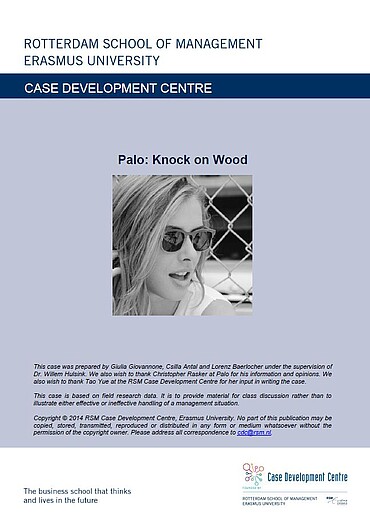description
Palo is a successful premium wooden eyewear brand. The expansion of the brand, however, is jeopardized by the lack of financial resources and production delays, as well as internal team conflict. Internal problems are coupled with the increasing competition. Palo is losing momentum and its first-mover advantage. Action is needed immediately if the company is to survive.
Citation Note
Based on field research; 16 pages.
Follow the 'handle' link to access the Case Study on RePub.
For EUR staff members: the Teaching Note is available on request, you can contact us at rsm.nl/cdc/contact/
For external users: follow the link to purchase the Case Study and the Teaching Note.
Objective
Learning objectives: The case aims to broaden the students’ knowledge on three related main areas. It examines born global companies, their international market selection strategy and their choice of distribution channels, highlighting the peculiarities of the distribution network for a manufacturing company. Students will be asked to apply notions and models from literature to each of the three areas, in order to test and develop their ability to make connections and theoretical analyses. But then, they will be challenged to “think out of the box”, and reflect about the idiosyncrasies of Palo and other wanna-be born global firms, whose challenges, limits and needs are still fledgling in literature. The case is designed for a 1.5 hour class session and is addressed to MBA, Phd, Bachelor and Master’s students in entrerpreneurship, management, business administration and related fields. The case provides also suitable insights for research papers about the main limitations and issues of born global firms.
Abstract
Palo is a premium wooden eyewear brand tailored to a particular niche of nonconformist people inspired by high quality and innovative products linked to nature. Products manufactured in China are shipped to many countries around the world, with the main focus on the European market. Initially the company expanded without a clear strategy and focus, making use of trade fairs and some existing contacts. They began selling in 21 countries, mainly through sales agents, distributors and by personally contacting retailers. After the initial successes, the expansion of the brand was jeopardized by the lack of financial resources and production delays, as well as internal team conflict. Internal problems were coupled with the increasing competition, as more and more start-ups entered the wooden eyewear market. Palo was losing momentum and its first mover advantage was rapidly disappearing. Action was needed immediately if the company was to survive. After Chris Rasker, the new CEO, took over the entire operations, he was eager to prioritize markets and find the right distribution channel among the wide spectrum of possible combinations.
